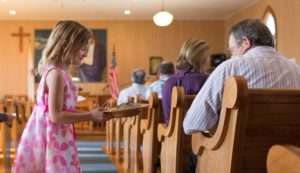Six months into the COVID-19 pandemic, the financial news from America’s religious congregations is not as dire as first predicted. Still, while some churches survive and even thrive, others struggle.
“In March we were readying up to help churches think through, ‘What do we do with a 30% to 40% budget shortfall this year,’” said Allen Walworth, executive vice president of Generis, financial consultants to churches and nonprofits. “Suddenly people aren’t coming to worship, can’t pass the plate, and all of that. And then of course the market tumbled a thousand points a day for a while. It really looked like it was going to be a very tough year.”

Allen Walworth
Generis works with hundreds of congregations at a time, and admittedly they have the financial wherewithal to employ consultants, said Walworth, but as of early August a third of them are doing better than they were at this time a year ago and a third are doing about the same.
“So, two-thirds of many of the strongest churches are doing as well or even better, which is a huge surprise and a wonderful thing,” he said. “And then there are a third about where we thought everybody was going to be, who are running significantly enough behind that they’re having to think through, ‘How do we right-size spending, personnel, those things.’”
A small sampling by The Church Network, an inter-denominational association of church business administrators, reveals similar results. Comparing unrestricted giving year over year from January through March when churches began closing, 48% reported giving was up, 10% said it was flat, and 42% said it was down. Comparing April 2019 to April 2020 when most churches were closed, 68% reported an increase in giving while 3% said it was flat. Among the 29% of churches reporting a decline in giving in April, 16% were down 1-9%, 10% were down 10-19%, and 3% were down 20% or more.
“I think even where there’s been contraction, churches have not had drastic amounts and in many cases those have been able to fill in the gap with the PPP loan, although that’s gone,” said Phill Martin, CEO of The Church Network. “When the Lake Institute completes their survey — which a whole lot of us are coming beside them and encouraging our constituents to participate because they have the engine to get the best results — we’ll know more. This thing’s moving fast.”
He’s talking about a new COVID-19 survey conducted by The Lake Institute on Faith and Giving at Indiana University’s Lilly Family School of Philanthropy. The survey was launched after the Fourth of July holiday and is a follow-on to the 2019 National Study of Congregations’ Economic Practices, which had approximately 1,200 respondents representing Christian, Jewish and Muslim congregations.
“Overall, the drastic predictions we saw about a drop-off in giving don’t seem to be as drastic as we thought for many congregations.”
“I can’t help but look a little bit,” said David King, director of the institute, a few days before the survey closed with more than 600 respondents thus far. “Overall, the drastic predictions we saw about a drop-off in giving don’t seem to be as drastic as we thought for many congregations. Particularly in the first few months of the pandemic, while giving may have sort of dipped here or there, for the most part it didn’t seem to be a dramatic drop off.”
Predictors of success
Initial feedback from surveys and conversations point to several predictors or determiners of success in negotiating the pandemic financially.
Walworth said a common trend among congregations that have not just survived but have thrived financially is that they were “internally healthy,” meaning they had a high level of trust in leadership, strong relationships and closeness within the church, and they were committed and involved in mission and ministry.
Another key factor was they ramped up quickly or were already prepared to provide virtual worship whether livestreamed or prerecorded.
“That made a huge difference in the giving because those are churches where the people kept seeing their church open, kept seeing their church caring for them and speaking to them and interpreting the times for them, and they kept that voice alive and there was huge interest in the church,” he said. “Like after 9/11 or any other crisis, people sort of return to their faith but in this case, they couldn’t run to the church like they did before. So being able to run to the church virtually — churches that could provide that was really important.”

Phill Martin
Martin at The Church Network had a similar perspective.
“I haven’t seen any research, but anecdotally, I sense that churches that have done a better job of keeping members engaged on a personal level, not just streaming services and/or having some kind of worship presence, but people who are actually interacting with their members in new and unique ways are having better luck and more consistency,” he said.
Hand in hand with keeping congregants connected virtually has been providing the means for them to continue giving.
“I think one of the things we know is churches who have really paid attention to ACH giving and online giving and app giving and text giving and had multiple platforms already in place and have been educating members about giving options have fared much better than churches who are catching up and who sort of had that but really didn’t pay a lot of attention to it,” Martin said.
King agreed with the importance of alternative means of giving and receiving gifts but added that congregations have fared better when they and their leaders were not afraid to talk about the need to continue giving — and not just to keep staff employed but to continue their mission in the community.
King said a negative that the pandemic is highlighting and that the Lake Institute survey will likely pick up on is the economic “fissure” that separates many congregations.
“It does demonstrate that there are haves and have nots among congregations across the nation,” he said. “Congregations that had good leadership and some of the technological infrastructure already in place have done better than we might have expected, but there are a number of congregations that have been hit extremely hard by the pandemic.”

David King
The “have nots” King spoke of are congregations that didn’t have technology in place for worship and giving, had higher percentages of members furloughed or had jobs eliminated because of their work in service industries, were situated in lower economic urban communities, or had bivocational pastors that may have also lost part of their income.
“That said, what I think we’re also seeing — my general perceptions having talked with a variety of religious leaders, pastors and networks of congregations — is that there is an extremely high level of resiliency among congregations, even more so than I would say for small businesses or other forms of nonprofits,” King said. “I think congregations will continue to exist even though they’ve been kind of beaten and battered financially by the downturn. Because they’re resilient, they can operate at a super-large scale or a super-small scale.”
The spending side
Giving is just one side of the church finance coin, and congregations have had to make adjustments on the expense side as well.
“Many people instantly pulled budgets back,” Martin said. And now churches that operate on a calendar fiscal year are heading into the budget planning season with new factors to consider.
“We’re seeing a number of churches who are rethinking staff structure, particularly with vacancies.”
“I sense a lot of optimism,” he said. “There’s not a, ‘the world is coming to an end, we don’t have the resources we need.’ It’s just a matter of rethinking and allocating and being very cautious and conservative about expenses and rethinking how those work. We’re seeing a number of churches who are rethinking staff structure, particularly with vacancies.”
Even before the pandemic, some churches already were looking at ways to trim personnel and facility costs.
“That was already in motion, and this is just going to catapult it,” Martin added. “When churches are doing construction, you’re not going to see the physical office for every staff member on campus. That’s just inevitable.”
What of the big campaigns?
Churches that were in the middle of capital campaigns for building projects or other programs also had to adjust not only with the pandemic but the falling financial markets, Walworth said.
“Some just sort of limped to the end because March might have been the end of the big public phase of their campaign, but none just fell apart,” he said. “The ones that were too late to stop just went right on and still had enough momentum and they still did OK.”
Meanwhile, churches that could pause capital campaigns did so, and they’ll resume when the time is right and depending on the urgency of their need.
“Beginning here in the summer and toward this fall, we’re seeing a number of those churches coming back online and saying, A, ‘It wasn’t as bad as we thought it was going to be; our church is doing well,’ and B, “We’ve all kind of gotten used to doing Zoom calls and doing virtual meetings.’”
The likely result will be campaigns that include virtual meetings, small meetings in large rooms, and then a public worship experience in the spring or later when that is possible again.
“It will still be hybrid, maybe for a couple of years, maybe forever,” Walworth said.
Learn from these best practices

Photo by Mike DuBose, UMNS
For those churches struggling financially due to the pandemic, Walworth suggested they take cues from the stronger churches and see what is possible.
“Really double down on finding ways to care,” he said. “As counterintuitive as it is, keep giving yourself away. Get out to where people are hurting — your own people but also people in the community — continue to witness to the gospel and tell that story.”
Even if the budget is strapped, he said, find a way to deploy technology for worship and to communicate what the church is doing. Look for used equipment if you need to and volunteers to operate it.
“Becoming more digital as opposed to analog in how we communicate and how we do worship is certainly going to be important,” he predicted. “Even when this eases out sometime next year, that’s going to be the new reality.”
The bottom line, Walworth said, is to “resist the temptation to draw the wagons into a circle and hunker down until the storm has passed. You don’t have to be foolish — it’s not like you should ignore the distancing warnings — but find ways to press with boldness and with the love of Christ to be involved in community ministry and care as a witness for those who never went to church and as a witness within the church of this is what we do. This is what we’re about, and it will help funding happen. It absolutely will.”


